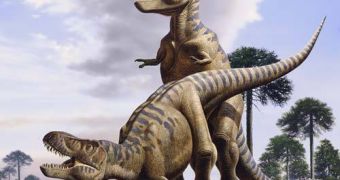Dinosaur teens were very naughty, just like the human ones. But they did not use contraceptives, and they bred even if they were teenagers, unlike birds, which are considered living dinosaurs, that have sex only after reaching an adult size. Sexual maturity before reaching adulthood is also found in crocodiles, alligators, lizards and snakes, the other living reptiles.
The discovery of the teen sex in dinosaurs was made by a team at the American Museum of Natural History in New York in all seven known specimens of dinosaurs that were found buried while brooding eggs. These fossils belonged to four oviraptorids (small, beaked, feathered birdlike bipeds), and three deinonychosaurs, over 10 feet (3 m) long predators endowed with unusually large sickle-shaped talons on their feet.
The researchers investigated the growth lines in the fossil bones, which just as in tree trunks, record an individual's age in lines suggesting a seasonal pause in the animal's growth.
"We looked at bones whose insides were already exposed. Sawing open perfectly good dinosaur bones is generally a no-no." said lead researcher Gregory Erickson, a Florida State University paleobiologist and AMNH research associate.
It took four years to see that five of the dinosaurs had grown to adult size, but two had not - one oviraptorid and one deinonychosaur. Thus, dinosaurs reached sexual maturity on a model similar to other reptiles.
"We're always telling kids that birds are like little T. rexes. Now that's true to some level, but not others. There are some attributes birds got from dinosaurian ancestors, but not others. Birds are really unusual in maturing so late sexually. Knowing when dinosaurs were capable of sex could shed light on which of the morphological features seen in fossils might be used in courtship displays and other behaviors," Erickson told LiveScience.
The new data explain more the way a dinosaur lived. For example, the oviraptorid Citipati osmolskae apparently could reproduce for seven to nine years. As this species laid about 20 eggs per clutch, one female could have laid 140 to 180 eggs during a lifetime. This is a reproductive strategy: high mortality of the infants was compensated by their sheer number.
"It's very clear now that these animals suffered very serious mortality levels early in life. Details such as that really help us understand their world better." said Erickson.

 14 DAY TRIAL //
14 DAY TRIAL //